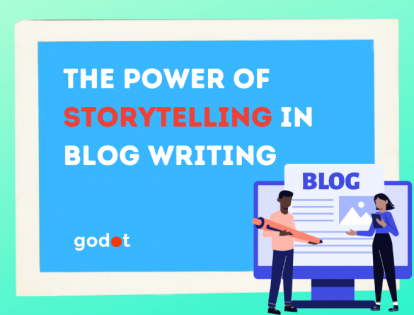In 2024, the number of blog posts published daily exceeded a whopping 7.5 million!
It’s quite a challenge to make your blog stand out in the vast, bustling marketplace of information we call the internet. By harnessing the power of storytelling, you can turn each post into an engaging narrative that not only holds your readers’ attention but also deeply resonates with them. It’s about turning facts and figures into stories, breathing life into your words, and creating a space where readers can laugh, think, and feel. So stick around to learn how storytelling can transform your blog writing, making complex ideas digestible and your brand voice unforgettable.

The importance of storytelling in blog writing
Storytelling isn’t just for novels or the big screen. It could be a powerful tool in your blog content strategy too. Leveraging the art of story can transform your blog from a mere dispenser of information to a captivating, memorable experience. Here’s why storytelling is so crucial in the blogosphere.
1. Captivates the audience
First up, it’s all about hooking your reader. And what better way to do that than with a good story? Think about it. When you start reading a post that kicks off with a real, human experience, you’re instantly more engaged. It’s like listening to a friend rather than sifting through a textbook. This initial hook keeps your audience reading longer, increasing the chances they’ll stick around, explore more, and maybe even hit that share button.
2. Establishes brand voice
Stories give your brand a voice—a personality. Instead of doling out facts and figures, sharing stories in your blog posts helps establish your brand as relatable, trustworthy, or perhaps even whimsical. This brand personality makes you stand out in a sea of similar content, creating a unique connection with your readers that goes beyond the transactional.
3. Creates an emotional connection
Finally, stories stimulate emotions, a key to building loyalty. When readers feel something, they’re more likely to remember your post and, by extension, your brand. Whether it’s joy from a humorous anecdote, inspiration from a success story, or even sadness from a more poignant tale, those emotions tie readers to your content on a deeper level.
How to incorporate stories in blog writing to simplify complex ideas

Writing about complex topics in your blog doesn’t doesn’t have to be a chore for you or a snooze-fest for your readers. By weaving in stories, you can make even the most complex concepts more relatable and understandable for your readers. An AI blog writer can make this job easier. It will not only help you articulate your thoughts effectively, but it will also keep you consistent in your storytelling. The AI can come up with captivating analogies or language that engages the readers and keeps them following along. Check out this quick guide on how to use an AI blog generator.
Here are some more tips on leveraging storytelling for blogging that resonates –
1. Start with a relevant anecdote
Begin your blog post with a brief, engaging anecdote related to your main topic. This story should not only grab attention but also seamlessly introduce the concept you’re about to unpack. For instance, if you’re explaining a technical process, a simple anecdote about a common problem it solves can bridge the gap between your reader’s experience and the information you’re presenting.
2. Use analogies and metaphors
Analogies and metaphors are your best friends when it comes to simplifying complex ideas. They help translate technical jargon or abstract concepts into familiar, relatable terms. If you’re discussing something like cloud computing, compare it to a library where you can borrow books (data and applications) whenever you need, instead of owning them all.
3. Introduce characters or personas
Creating a character or persona can make your story—and by extension, your blog post—more relatable. For instance, meet Jamie, a small business owner who’s navigating the world of online marketing for the first time. Through Jamie’s trials and successes, you can illustrate various marketing strategies or pitfalls in a way that’s engaging and educational.
4. Incorporate real-life success stories or examples
Nothing says “this works” quite like a real-life success story. By showcasing how individuals or businesses have successfully implemented a strategy, solved a problem, or made a significant change, you make your point more convincing. It not only illustrates your point but also provides inspiration and a practical guide for your readers.
5. Supplement your storytelling with visual elements
Visual elements like images, infographics, and videos can enrich your storytelling, making complex ideas more digestible. For example, a comparative infographic can visually simplify a comparison that might be clunky and confusing if conveyed through text alone. Visuals also break up the text, making your post more attractive and easier to read. If you’re tired of using same old stock images, try using an AI image generator to generate unique images from simple text prompts.
6. Include quotes or testimonials
Quotes or testimonials can serve as mini-stories within your blog post, adding authenticity and credibility to your message. When you share what others have said or experienced, it’s like offering proof that adds weight to your narrative. This tactic is particularly effective in posts where direct evidence can support your main story or argument.
7. Summarize the main points and tie them back to the initial story or anecdote
To wrap up your blog post, circle back to the story or anecdote you started with. This not only brings your post full circle, creating a satisfying conclusion but also reinforces the main points you’ve made throughout. Summarize the key takeaways, and link them back to the initial story, emphasizing how the narrative journey you’ve taken your readers on answers questions or solves the problem you introduced at the beginning.

8.Use SEO to unlock the potential of your blog posts
When it comes to blog writing, storytelling is a powerful tool, but it’s not enough to captivate your readers. You also need to consider the importance of blog SEO to ensure your stories reach a wider audience. By conducting thorough keyword research, writing compelling meta descriptions, optimizing images, and using internal and external links, you can unlock the full potential of your stories and attract a larger audience.
Wrap up
Incorporating storytelling into your blog content is less about becoming a novelist and more about thinking like one. Even in a post brimming with data, industry insights, or technical descriptions, a narrative approach can make your content more accessible, memorable, and impactful. Start weaving those stories into your content strategy, and watch how they drive traffic, foster engagement, and simplify even the most complex ideas for your readers.
Looking to enhance your company blog and boost your online presence? Godot blog writing service is the solution you’ve been searching for! Get content tailored to your unique audience and business needs, crafted by expert writers with a knack for storytelling. Fill out your order form here.

